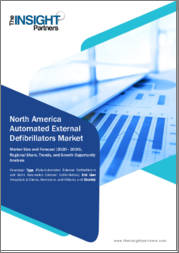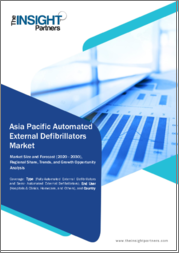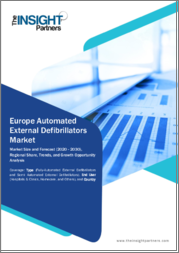
|
시장보고서
상품코드
1441394
세계 자동 체외식 제세동기 시장 : 규모,예측 - 분석 유형별, 최종 사용자별, 지역별 분석(2023-2030년)Global Automated External Defibrillators Market Size study & Forecast, by Analysis Type, by End User and Regional Analysis, 2023-2030 |
||||||
세계 자동 체외식 제세동기 시장 규모는 2022년에 약 8억 1,000만 달러로 평가되었고, 예측기간(2023년-2030년) 동안 8.78%초과의 견실한 성장률로 성장할 것으로 예측되고 있습니다. 자동 체외식 제세동기는 생명을 위협하는 부정맥, 특히 심실세동이나 심실 빈박을 분석,치료하기 위해서 설계된 휴대형 전자 기기입니다.
이러한 상태는 심장의 정상적인 리듬이 흐트러져 혈액을 효과적으로 전달할 수 없게 되는 의료 긴급 상황인 갑작스런 심정지로 이어질 수 있습니다. 자동 체외식 제세동기 시장은 노인 인구 증가와 심혈관 질환을 앓고 있는 사람의 급증 등의 요인에 의해 확대되고 있습니다. 자동 체외식 제세동기는 최소한의 의료 훈련으로 개인에서도 사용할 수 있는 사용자 친화적인 장비입니다. 심장 리듬을 분석하고 정상적인 심장 박동을 되찾기 위해 전기 충격이 필요한지 여부를 결정하는 센서를 갖추고 있습니다. 그 결과, 자동 체외식 제세동기 수요는 2023-2030년 예측기간 동안 국제시장에서 점차 증가할 전망입니다.
나이가 들수록 심혈관 장애에 대한 감수성이 높아지고 갑작스런 심정지의 위험이 높아집니다. 이러한 상황에서는 자동 체외식 제세동기가 신속한 개입을 위해 필수적입니다. 세계보건기구(WHO)에 따르면 세계 60세 이상의 인구는 2050년까지 약 21억 명으로 두배로 될 것으로 예측됩니다. 또한 80세 이상의 인구는 2020년-2050년 사이에 3배로 증가하여 4억 2,600만명에 달할 것으로 예측되고 있습니다. 게다가 노령화는 AED의 중요성을 증가시키고 다양한 건강 관리 현장에서의 가용성, 인지도 및 교육의 필요성을 증가시키고 있습니다. 자동 체외식 제세동기 시장을 견인하는 또 다른 중요한 요인은 심혈관 질환을 앓고 있는 사람들 증가입니다. 심혈관 질환의 유병률 증가로 갑작스런 심정지가 발생할 가능성이 높아지고, 결국 공공장소, 직장, 의료시설 등 다양한 장면에서 자동 체외식 제세동기 수요 가 증가했습니다. 또한 2020년 미국 심장협회가 밝힌 바에 따르면 미국에서는 관상동맥성 심질환이 주요 원인이며 CVD 관련 사망률의 41.2%를 차지한 다음 뇌졸중이 17.3%, 그 밖의 심혈관 질환이 16.8%, 고혈압이 12.9%, 심부전이 9.2%, 동맥 질환이 2.6%입니다. 또한, 체외식 제세동기의 기술적 진보와 심혈관 수술 건수 증가가 예측 기간 동안 시장에 유리한 성장 기회를 가져올 것으로 예상됩니다. 그러나 자동 체외식 제세동기와 관련된 높은 비용과 인지도 부족이 2023년-2030년의 예측 기간을 통해 시장 전체의 성장을 방해할 것으로 보입니다.
자동 체외식 제세동기 시장 조사에서 고려한 주요 지역에는 아시아태평양, 북미, 유럽, 라틴아메리카, 중동 및 아프리카가 포함됩니다. 북미는 노인 인구 증가, 심정지로 인한 사망자 수 증가, 제세동기 기술 향상에 대한 주목이 높아짐에 따라 2022년 시장을 독점했습니다. 제세동기의 지속적인 기술 발전은 적시에 정확한 제세동을 제공하는 효과에 기여합니다. 향상된 알고리즘, 사용자 인터페이스 및 진단 기능은 비상시 자동 체외식 제세동기의 사용을 최적화하는 데 도움이 됩니다. 이 지역의 압도적인 실적은 자동 체외식 제세동기의 전반적인 수요를 촉진할 것으로 예상됩니다. 또한 북미는 이 지역의 건강 관리 산업 확대와 같은 요인으로 인해 예측 기간 동안 가장 빠르게 성장할 것으로 예상됩니다. 헬스케어 산업은 직원의 의식 향상과 트레이닝 이니셔티브를 추진하고 심장의 긴급 사태에 대응할 수 있는 환경을 정돈하는 역할을 할 수 있습니다.
본 연구의 목적은 최근 여러 부문와 국가 시장 규모를 밝히고 향후 수년간 시장 규모를 예측하는 것입니다. 이 보고서는 조사 대상 국가에서 업계의 질적 및 양적 측면을 모두 포함하도록 설계되었습니다.
또한 시장의 미래 성장을 규정하는 촉진요인과 과제 등 중요한 측면에 대한 자세한 정보도 제공합니다. 또한 주요 기업의 경쟁 구도와 제품 제공에 대한 상세한 분석과 함께 이해관계자가 투자할 수 있는 마이크로시장의 잠재적인 기회도 포함하고 있습니다.
목차
제1장 주요 요약
제2장 자동 체외식 제세동기 시장 정의와 범위
- 조사 목적
- 시장 정의와 범위
- 산업의 진화
- 조사 범위
- 조사 대상년도
- 환율 변환율
제3장 자동 체외식 제세동기 시장 역학
- 자동 체외식 제세동기 시장의 영향 분석(2020년-2030년)
- 시장 성장 촉진요인
- 고령자 인구 증가
- 심혈관 질환을 앓고 있는 사람들의 급증
- 시장의 과제
- 자동 체외식 제세동기에 관련된 고비용
- 인지도의 부족
- 시장 기회
- 자동 체외식 제세동기의 기술적 진보
- 심장혈관 수술 증가
- 시장 성장 촉진요인
제4장 자동 체외식 제세동기의 시장 분석
- Porter's Five Forces 모델
- 공급기업의 협상력
- 구매자의 협상력
- 신규 참가업체의 위협
- 대체품의 위협
- 경쟁 기업간 경쟁 관계
- Porter's Five Forces의 영향 분석
- PEST 분석
- 정치
- 경제
- 사회
- 기술
- 환경
- 법률
- 주요 투자 기회
- 주요 성공 전략
- COVID-19의 영향 분석
- 파괴적 동향
- 업계 전문가의 시점
- 애널리스트의 결론 및 제안
제5장 자동 체외식 제세동기 시장 : 분석 유형별
- 시장 현황
- 자동 체외식 제세동기 시장 : 분석 유형별, 실적-가능성 분석
- 자동 체외식 제세동기 시장 : 분석 유형별, 추정 및 예측(2020년-2030년)
- 자동 체외식 제세동기 시장 : 하위 부문 분석
- 반자동 체외식 제세동기
- 전자동 체외식 제세동기
제6장 자동 체외식 제세동기 시장 : 최종 사용자별
- 시장 현황
- 자동 체외식 제세동기 시장 : 최종 사용자별, 실적 - 잠재력 분석
- 자동 체외식 제세동기 시장 : 최종사용자별, 추정 및 예측(2020년-2030년)
- 자동 체외식 제세동기 시장 : 하위 부문 분석
- 병원/진료소
- 재택치료
- 기타 최종 사용자
제7장 자동 체외식 제세동기 시장 : 지역 분석
- 주요국
- 주요 신흥국
- 자동 체외식 제세동기 시장 :지역 시장 현황
- 북미
- 미국
- 분석 유형의 추정 및 예측(2020년-2030년)
- 최종 사용자의 추정 및 예측(2020년-2030년)
- 캐나다
- 미국
- 유럽
- 영국
- 독일
- 프랑스
- 스페인
- 이탈리아
- 기타 유럽
- 아시아태평양
- 중국
- 인도
- 일본
- 호주
- 한국
- 기타 아시아태평양
- 라틴아메리카
- 브라질
- 멕시코
- 중동 및 아프리카
- 사우디아라비아
- 남아프리카
- 기타 중동 및 아프리카
제8장 경쟁 정보
- 주요 기업의 SWOT 분석
- 주요 시장 전략
- 기업 프로파일
- Asahi Kasei Corporation
- Stryker Corporation
- Nihon Kohden Corporation
- Koninklijke Philips NV
- Mediana Co. Ltd
- Schiller AG
- Cardiac Science Corporation
- Zoll Medical Corporation
- Metrax GmbH
- GE Healthcare
제9장 조사 과정
- 조사 과정
- 데이터 마이닝
- 분석
- 시장 추정
- 검증
- 출판
- 조사 속성
- 조사의 전제조건
Global Automated External Defibrillators Market is valued at approximately USD 0.81 billion in 2022 and is anticipated to grow with a healthy growth rate of more than 8.78 % during the forecast period 2023-2030. Automated External Defibrillators are portable electronic devices designed to analyze and treat life-threatening cardiac arrhythmias, specifically ventricular fibrillation and ventricular tachycardia. These conditions can lead to sudden cardiac arrest, a medical emergency where the heart's normal rhythm is disrupted, and it is unable to pump blood effectively. The Automated External Defibrillators Market is expanding because of factors such as the increasing number of aging populations and surge in the number of people suffering from cardiovascular diseases. Automated External Defibrillators are user-friendly devices that can be used by individuals with minimal medical training. They are equipped with sensors that analyze the heart's rhythm and determine if an electrical shock is necessary to restore a normal heartbeat. As a result, the demand for Automated External Defibrillators has progressively increased in the international market during the forecast period 2023-2030.
Individuals become increasingly sensitive to cardiovascular disorders as they age, which increases the risk of sudden cardiac arrest. In such situations, Automated External Defibrillators become critical for giving quick intervention. According to the World Health Organization, the world's population of persons aged 60 and more is anticipated to double approx. 2.1 billion by 2050. The number of people aged 80 and more is predicted to thrice between years 2020 and 2050, reaching 426 million. Furthermore, the aging population can amplify the importance of AEDs, prompting a need for increased availability, awareness, and training in various healthcare settings. Another important factor that drives the Automated External Defibrillators Market is the increasing number of people suffering from cardiovascular diseases. The growing prevalence of cardiovascular diseases led to increasing chances of sudden cardiac arrest events, which eventually created a greater demand for Automated External Defibrillators in various situations, including public places, workplaces, and healthcare facilities. In addition, in 2020, the American Heart Association revealed that in the United States, coronary heart disease was held accountable for the primary cause, responsible for 41.2% of CVD-related deaths, followed by stroke at 17.3%, other cardiovascular diseases at 16.8%, high blood pressure at 12.9%, heart failure at 9.2%, and diseases of the arteries at 2.6%. Moreover, technological advancements in external defibrillators devices and the increasing number of cardiovascular surgeries are anticipated to create lucrative growth opportunities for the market over the forecast period. However, the high cost associated with automated external defibrillators and lack of awareness is going to impede overall market growth throughout the forecast period of 2023-2030.
The key regions considered for the Global Automated External Defibrillators Market study includes Asia Pacific, North America, Europe, Latin America, and Middle East & Africa. North America dominated the market in 2022 owing to growing geriatric population, increasing number of persons dying due to cardiac arrest, and rising emphasis on technological improvement in defibrillators in the region. Ongoing technological advancements in Defibrillators contribute to their effectiveness in delivering timely and accurate defibrillation. Enhanced algorithms, user interfaces, and diagnostic capabilities help optimize the use of Automated External Defibrillators in emergencies. The region's dominant performance is anticipated to propel the overall demand for Automated External Defibrillators. Furthermore, North America is expected to grow fastest over the forecast period, owing to factors such as the expansion of the healthcare industry in the region. The healthcare industry can play a role in promoting awareness and training initiatives among its workforce, creating a more prepared environment for responding to cardiac emergencies.
Major market player included in this report are:
- Asahi Kasei Corporation
- Stryker Corporation
- Nihon Kohden Corporation
- Koninklijke Philips NV
- Mediana Co. Ltd
- Schiller AG
- Cardiac Science Corporation
- Zoll Medical Corporation
- Metrax GmbH
- GE Healthcare
Recent Developments in the Market:
- In January 2023, Avive Solutions, Inc. got approval from the U.S. Food and Drug Administration (FDA), obtaining Pre-Market Approval (PMA) for its innovative Avive AED, an Automated External Defibrillator. This device has cellular, WiFi, GPS, and Bluetooth connectivity. Avive's breakthrough REALConnect Technology is powered by this connection package. It is intended to assist people access life-saving therapy when and where they need it by integrating with 911 centres through a partnership with RapidSOS. It also effortlessly communicates critical incident data to 911 dispatchers, EMS, and medical professionals at the appropriate time. REALConnect can also automate remote monitoring of Avive's AEDs to ensure proper maintenance and functionality.
Global Automated External Defibrillators Market Report Scope:
- Historical Data - 2020 - 2021
- Base Year for Estimation - 2022
- Forecast period - 2023-2030
- Report Coverage - Revenue forecast, Company Ranking, Competitive Landscape, Growth factors, and Trends
- Segments Covered - Analysis Type, End User, Region
- Regional Scope - North America; Europe; Asia Pacific; Latin America; Middle East & Africa
- Customization Scope - Free report customization (equivalent up to 8 analyst's working hours) with purchase. Addition or alteration to country, regional & segment scope*
The objective of the study is to define market sizes of different segments & countries in recent years and to forecast the values to the coming years. The report is designed to incorporate both qualitative and quantitative aspects of the industry within countries involved in the study.
The report also caters detailed information about the crucial aspects such as driving factors & challenges which will define the future growth of the market. Additionally, it also incorporates potential opportunities in micro markets for stakeholders to invest along with the detailed analysis of competitive landscape and product offerings of key players. The detailed segments and sub-segment of the market are explained below:
By Analysis Type
- Semi-automated External Defibrillators
- Fully-automated External Defibrillators
By End User
- Hospitals/Clinics
- Home Care
- Other End Users
By Region:
- North America
- U.S.
- Canada
- Europe
- UK
- Germany
- France
- Spain
- Italy
- ROE
- Asia Pacific
- China
- India
- Japan
- Australia
- South Korea
- RoAPAC
- Latin America
- Brazil
- Mexico
- Middle East & Africa
- Saudi Arabia
- South Africa
- Rest of Middle East & Africa
Table of Contents
Chapter 1. Executive Summary
- 1.1. Market Snapshot
- 1.2. Global & Segmental Market Estimates & Forecasts, 2020-2030 (USD Billion)
- 1.2.1. Automated External Defibrillators Market, by Region, 2020-2030 (USD Billion)
- 1.2.2. Automated External Defibrillators Market, by Analysis Type, 2020-2030 (USD Billion)
- 1.2.3. Automated External Defibrillators Market, by End User, 2020-2030 (USD Billion)
- 1.3. Key Trends
- 1.4. Estimation Methodology
- 1.5. Research Assumption
Chapter 2. Global Automated External Defibrillators Market Definition and Scope
- 2.1. Objective of the Study
- 2.2. Market Definition & Scope
- 2.2.1. Industry Evolution
- 2.2.2. Scope of the Study
- 2.3. Years Considered for the Study
- 2.4. Currency Conversion Rates
Chapter 3. Global Automated External Defibrillators Market Dynamics
- 3.1. Automated External Defibrillators Market Impact Analysis (2020-2030)
- 3.1.1. Market Drivers
- 3.1.1.1. Increasing number of aging populations
- 3.1.1.2. Surge in number of people suffering from cardiovascular diseases
- 3.1.2. Market Challenges
- 3.1.2.1. High cost associated with Automated External Defibrillators
- 3.1.2.2. Lack of awareness
- 3.1.3. Market Opportunities
- 3.1.3.1. Technological advancements in External Defibrillators devices
- 3.1.3.2. Increasing number of cardiovascular surgeries
- 3.1.1. Market Drivers
Chapter 4. Global Automated External Defibrillators Market Industry Analysis
- 4.1. Porter's 5 Force Model
- 4.1.1. Bargaining Power of Suppliers
- 4.1.2. Bargaining Power of Buyers
- 4.1.3. Threat of New Entrants
- 4.1.4. Threat of Substitutes
- 4.1.5. Competitive Rivalry
- 4.2. Porter's 5 Force Impact Analysis
- 4.3. PEST Analysis
- 4.3.1. Political
- 4.3.2. Economical
- 4.3.3. Social
- 4.3.4. Technological
- 4.3.5. Environmental
- 4.3.6. Legal
- 4.4. Top investment opportunity
- 4.5. Top winning strategies
- 4.6. COVID-19 Impact Analysis
- 4.7. Disruptive Trends
- 4.8. Industry Expert Perspective
- 4.9. Analyst Recommendation & Conclusion
Chapter 5. Global Automated External Defibrillators Market, by Analysis Type
- 5.1. Market Snapshot
- 5.2. Global Automated External Defibrillators Market by Analysis Type, Performance - Potential Analysis
- 5.3. Global Automated External Defibrillators Market Estimates & Forecasts by Analysis Type 2020-2030 (USD Billion)
- 5.4. Automated External Defibrillators Market, Sub Segment Analysis
- 5.4.1. Semi-automated External Defibrillators
- 5.4.2. Fully-automated External Defibrillators
Chapter 6. Global Automated External Defibrillators Market, by End User
- 6.1. Market Snapshot
- 6.2. Global Automated External Defibrillators Market by End User, Performance - Potential Analysis
- 6.3. Global Automated External Defibrillators Market Estimates & Forecasts by End User 2020-2030 (USD Billion)
- 6.4. Automated External Defibrillators Market, Sub Segment Analysis
- 6.4.1. Hospitals/Clinics
- 6.4.2. Home Care
- 6.4.3. Other End Users
Chapter 7. Global Automated External Defibrillators Market, Regional Analysis
- 7.1. Top Leading Countries
- 7.2. Top Emerging Countries
- 7.3. Automated External Defibrillators Market, Regional Market Snapshot
- 7.4. North America Automated External Defibrillators Market
- 7.4.1. U.S. Automated External Defibrillators Market
- 7.4.1.1. Analysis Type breakdown estimates & forecasts, 2020-2030
- 7.4.1.2. End User breakdown estimates & forecasts, 2020-2030
- 7.4.2. Canada Automated External Defibrillators Market
- 7.4.1. U.S. Automated External Defibrillators Market
- 7.5. Europe Automated External Defibrillators Market Snapshot
- 7.5.1. U.K. Automated External Defibrillators Market
- 7.5.2. Germany Automated External Defibrillators Market
- 7.5.3. France Automated External Defibrillators Market
- 7.5.4. Spain Automated External Defibrillators Market
- 7.5.5. Italy Automated External Defibrillators Market
- 7.5.6. Rest of Europe Automated External Defibrillators Market
- 7.6. Asia-Pacific Automated External Defibrillators Market Snapshot
- 7.6.1. China Automated External Defibrillators Market
- 7.6.2. India Automated External Defibrillators Market
- 7.6.3. Japan Automated External Defibrillators Market
- 7.6.4. Australia Automated External Defibrillators Market
- 7.6.5. South Korea Automated External Defibrillators Market
- 7.6.6. Rest of Asia Pacific Automated External Defibrillators Market
- 7.7. Latin America Automated External Defibrillators Market Snapshot
- 7.7.1. Brazil Automated External Defibrillators Market
- 7.7.2. Mexico Automated External Defibrillators Market
- 7.8. Middle East & Africa Automated External Defibrillators Market
- 7.8.1. Saudi Arabia Automated External Defibrillators Market
- 7.8.2. South Africa Automated External Defibrillators Market
- 7.8.3. Rest of Middle East & Africa Automated External Defibrillators Market
Chapter 8. Competitive Intelligence
- 8.1. Key Company SWOT Analysis
- 8.1.1. Company 1
- 8.1.2. Company 2
- 8.1.3. Company 3
- 8.2. Top Market Strategies
- 8.3. Company Profiles
- 8.3.1. Asahi Kasei Corporation
- 8.3.1.1. Key Information
- 8.3.1.2. Overview
- 8.3.1.3. Financial (Subject to Data Availability)
- 8.3.1.4. Product Summary
- 8.3.1.5. Recent Developments
- 8.3.2. Stryker Corporation
- 8.3.3. Nihon Kohden Corporation
- 8.3.4. Koninklijke Philips NV
- 8.3.5. Mediana Co. Ltd
- 8.3.6. Schiller AG
- 8.3.7. Cardiac Science Corporation
- 8.3.8. Zoll Medical Corporation
- 8.3.9. Metrax GmbH
- 8.3.10. GE Healthcare
- 8.3.1. Asahi Kasei Corporation
Chapter 9. Research Process
- 9.1. Research Process
- 9.1.1. Data Mining
- 9.1.2. Analysis
- 9.1.3. Market Estimation
- 9.1.4. Validation
- 9.1.5. Publishing
- 9.2. Research Attributes
- 9.3. Research Assumption

















